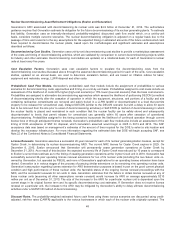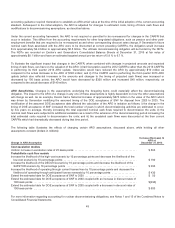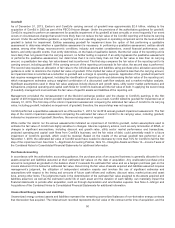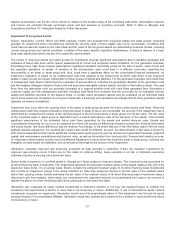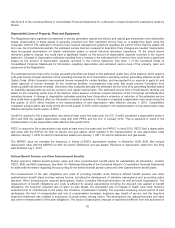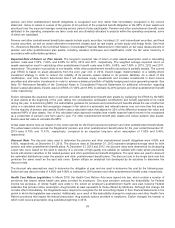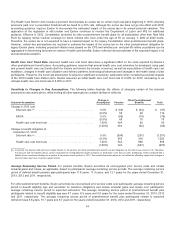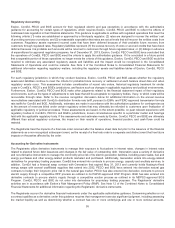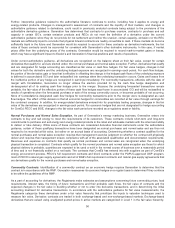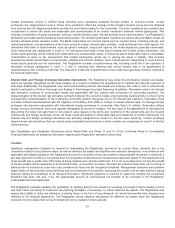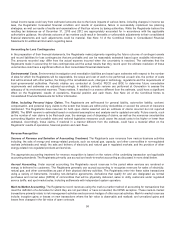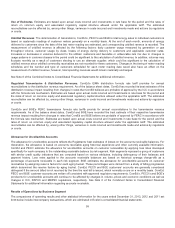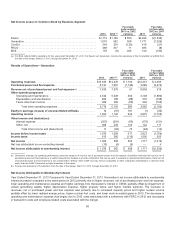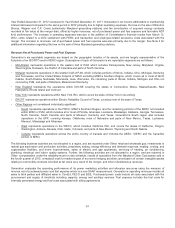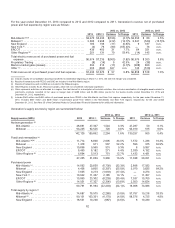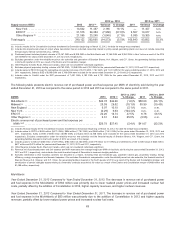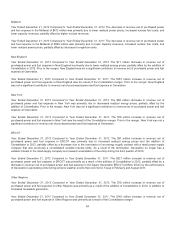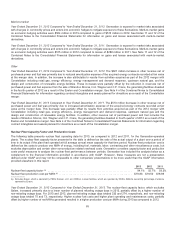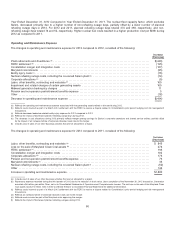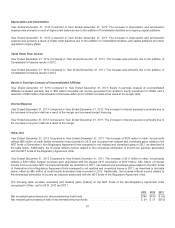ComEd 2013 Annual Report Download - page 64
Download and view the complete annual report
Please find page 64 of the 2013 ComEd annual report below. You can navigate through the pages in the report by either clicking on the pages listed below, or by using the keyword search tool below to find specific information within the annual report.Actual incometaxescouldvaryfromestimatedamountsdue to thefuture impactsofvariousitems, includingchangesinincometax
laws, theRegistrants’ forecastedfinancial condition andresultsofoperations, failure to successfullyimplement taxplanning
strategies, aswell asresultsofauditsandexaminationsoffiledtaxreturnsbytaxingauthorities. While theRegistrantsbelievethe
resultingtaxbalancesasofDecember 31,2013 and2012 are appropriatelyaccountedfor inaccordancewiththe applicable
authoritativeguidance,the ultimate outcomeoftaxmatterscouldresult infavorable or unfavorable adjustmentsto theirconsolidated
financial statementsandsuch adjustmentscouldbematerial.See Note 14oftheCombinedNotesto ConsolidatedFinancial
Statementsfor additional information regardingtaxes.
Accounting for Loss Contingencies
Inthe preparation oftheirfinancial statements, theRegistrantsmakejudgmentsregardingthefuture outcomeofcontingent events
andrecordliabilitiesfor loss contingenciesthat are probable andcan be reasonablyestimatedbasedupon available information.
Theamountsrecordedmay differ fromtheactual expenseincurredwhen theuncertaintyisresolved. Theestimatesthat the
Registrantsmakeinaccountingfor loss contingenciesandtheactual resultsthat theyrecordupon the ultimate resolution ofthese
uncertaintiescouldhaveasignificant effectontheirconsolidatedfinancial statements.
Environmental Costs. Environmental investigation andremediation liabilitiesare basedupon estimateswithrespecttothenumber
ofsitesfor which theRegistrantswill beresponsible,thescope andcostofworkto be performedat each site,the portion ofcosts
that will besharedwithother parties, thetimingoftheremediation work, changesintechnology, regulationsandtherequirementsof
local governmental authorities. Periodic studiesare conductedat ComEd, PECO and BGE to determine future remediation
requirementsandestimatesare adjustedaccordingly. Inaddition,periodic reviews are performedat Generation to assess the
adequacy ofitsenvironmental reserves. Thesematters, if resolvedinamanner different fromtheestimate,couldhaveasignificant
effectontheRegistrants’ resultsofoperations, financial position andcash flows. See Note 22 oftheCombinedNotesto
ConsolidatedFinancial Statementsfor further information.
Other, Including Personal Injury Claims. TheRegistrantsare self-insuredfor general liability, automotiveliability, workers’
compensation,andpersonal injuryclaims to theextent that lossesare within policy deductiblesor exceedtheamount ofinsurance
maintained. TheRegistrantshavereservesfor bothopen claims assertedandan estimate ofclaims incurredbut not reported
(IBNR). TheIBNRreserveis estimatedbasedon actuarial assumptionsandanalysis andisupdatedannually. Future events, such
asthenumber ofnewclaims to befiledeach year,theaveragecostof disposingofclaims, aswell asthenumerousuncertainties
surroundinglitigation andpossible state andnational legislativemeasurescouldcausetheactual coststo behigher or lower than
estimated. Accordingly, theseclaims, if resolvedinamanner different fromtheestimate,couldhaveamaterial effectonthe
Registrants’ resultsofoperations, financial position andcash flows.
Revenue Recognition
Sources of Revenue and Selection of Accounting Treatment. TheRegistrantsearn revenuesfromvariousbusiness activities
including: thesale ofenergy andenergy-relatedproducts, such asnatural gas, capacity, andother commoditiesin non-regulated
markets (wholesale andretail);thesale anddeliveryofelectricityandnatural gasinregulatedmarkets; andthe provision ofother
energy-relatednon-regulatedproductsandservices.
The appropriate accountingtreatment for revenue recognition is basedon the nature oftheunderlyingtransaction andapplicable
accountingstandards. TheRegistrantsprimarilyuseaccrual andmark-to-market accountingas discussedinmore detailbelow.
Accrual Accounting. Under accrual accounting, theRegistrantsrecordrevenuesinthe periodwhen servicesare renderedor
energy is deliveredto customers. TheRegistrantsgenerallyuseaccrual accountingto recognizerevenuesfor salesofelectricity,
natural gas, andother commoditiesaspart oftheirphysical deliveryactivities. TheRegistrantsenter into thesesalestransactions
usingavarietyofinstruments, includingnon-derivativeagreements, derivativesthat qualify for andare designatedasnormal
purchasesandnormal sales (NPNS) ofcommoditiesthat will bephysicallydelivered, salesto utilitycustomersunder regulated
service tariffs, andspot-market sales, includingsettlementswithindependent systemoperators.
Mark-to-Market Accounting. TheRegistrantsrecordrevenuesusingthemark-to-market methodofaccountingfor transactionsthat
meet thedefinition ofaderivativefor which theyare not permitted, or have not elected, theNPNS exception.Thesemark-to-market
transactionsprimarilyrelate to risk management activitiesandeconomic hedgesofother accrual activities. Mark-to-market revenues
include:inception gainsor losseson newtransactionswhere thefairvalue is observable andrealized; andunrealizedgainsand
lossesfromchangesinthefairvalue ofopen contracts.
58


